Computex 2011: SandForce mSATA Drives & No More Supercap
by Anand Lal Shimpi on May 30, 2011 3:22 AM EST- Posted in
- SSDs
- SandForce
- SF-2000
- Computex 2011
- Trade Shows
I haven't been to Computex since 2005. I felt that for a while there the show had lost some of its appeal. Motherboards alone weren't all that interesting and there was a lot of confusion in the market as to what to focus on next. These past couple of years I've seen a lot more news items of interest come out of Taiwan and after regretting not being at the show last year, I made it a point to show up this year.
My first meeting actually took place at LAX last night, hours before my flight with a couple of guys from SandForce. Hot on the heels of the SF-2000 family release there's really not much new to talk about from a technology standpoint but SandForce did have a couple of updates to give me.
First is an mSATA reference design based around the SF-2281 controller we've seen used in drives like the Vertex 3 and Agility 3:
SandForce has both a 4-channel and an 8-channel version of the mSATA drive (right and left in the picture above, respectively).
In order to route to the additional channels SandForce had to go with BGA NAND devices for the faster drive, which is the main difference between the two cards.
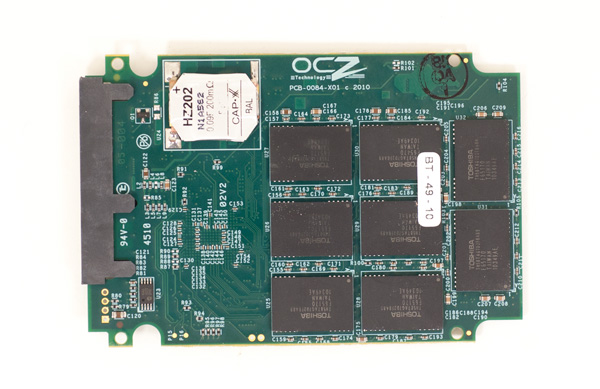
OCZ's Vertex 3 Pro pre-release sample with supercap
The other neat thing SandForce showed me was one of its enterprise SF-2000 reference designs. If you remember back to our Vertex 3 Pro Preview, SandForce's enterprise designs used a beefy capacitor to help flush data to NAND in the event of a sudden power failure. Unfortunately OEMs had concerns about the reliability of that supercap under load over the lifetime of the drive. Intel realized the same issues and opted for smaller polymer caps in its SSD 320 drive:
Below is a SF reference design that uses an array of similar capacitors instead of the single supercap:
With an array of smaller capacitors the drive can withstand a failure of some in the array and still maintain data integrity in the event of a power failure. SandForce has shown an incredible amount of focus this generation on dealing with the issues that plagued it last generation. Firmware is more reliable, more time was spent on validation testing and with things like the move to smaller caps OEM needs are being met.


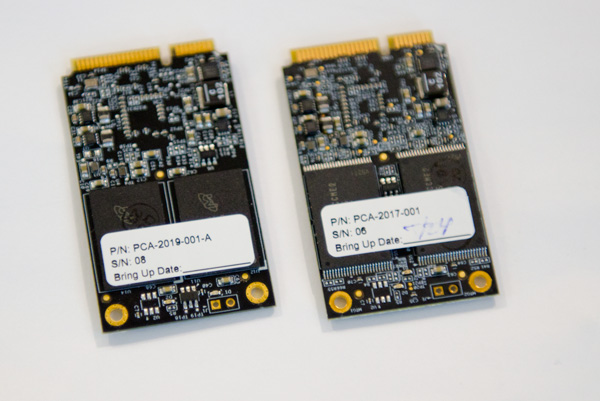
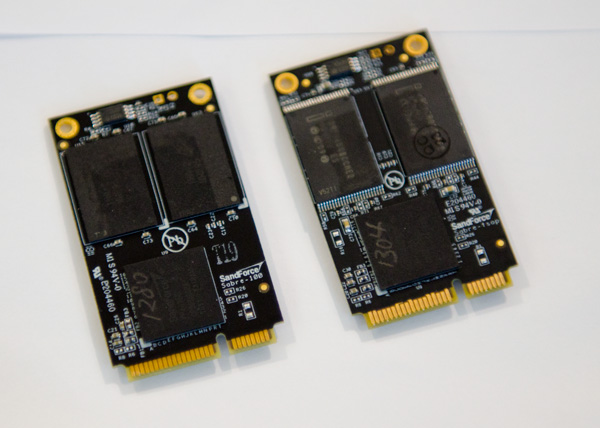
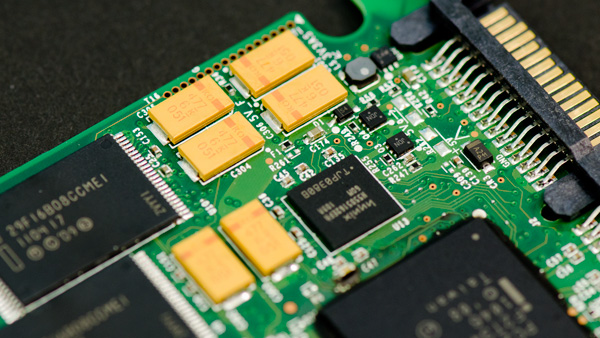
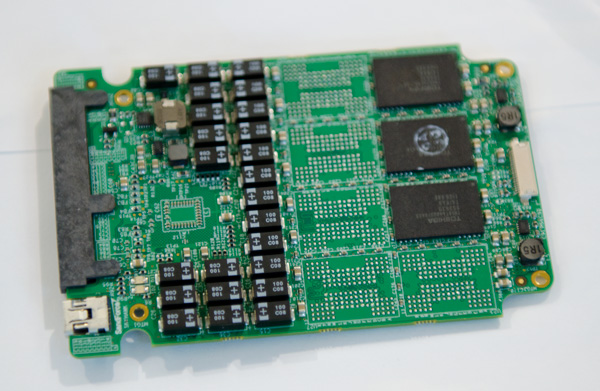
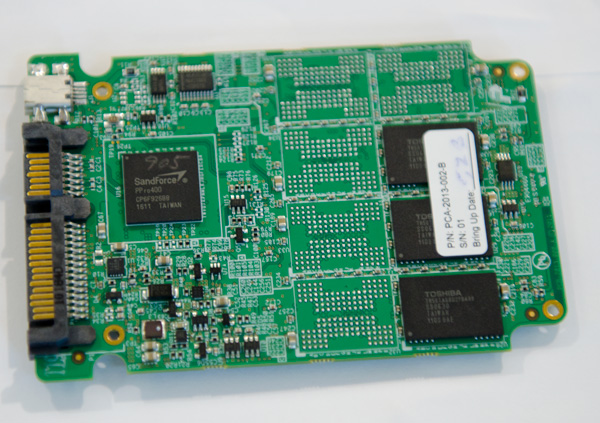








10 Comments
View All Comments
iwod - Monday, May 30, 2011 - link
Anand: Could mSATA do 6Gbps? Since it is SATA protocol routed through Mini PCI Express Signal, 1x PCI-E 2.0 could only do 500MBps, so are these mSATA 2x Slot?Or since SATA is a Half Duplex connection, a Full Duplex 500MBps ( 1GB both direction ) would handle the loads with minimals performance different?
A Chance we could see these inside new Macbook Air?
Kristian Vättö - Monday, May 30, 2011 - link
Is the signal Mini PCIe? All articles and figures I've seen indicate that mSATA is exactly the same as regular SATA but with a difference connector. Even Intel's datasheet does not mention anything about PCIehttp://download.intel.com/design/flash/nand/324042...
BioTurboNick - Monday, May 30, 2011 - link
The mSATA connector is the same connector as Mini-PCIe, but it depends on the motherboard having a dedicated SATA controller on the PCI express bus.Movieman420 - Monday, May 30, 2011 - link
Hate to rain on the parade but there are still several issues with the SF1200 drives that remain blatantly unresolved. The cold boot issue, the disappearing from bios issue, the 'time warp' issue, and the laptop sleep issue that bricks drives to name a few. One quick look at the Ocz forum and you'll see there are numerous complaints about stuttering followed by a BSOD. Also have reports of the 'disappearing from bios' issue. SF has a loooong road ahead if they think the above is progress. SF's ability to code FW for their own product seems to be entirely adequate. I speak from experience with a 4 drive array that suffers from the cold boot issue. Anytime I cold boot, I have to wait until it tries to find the undetected drives then hit ctrl-alt-del to cause a warm reboot and then they detect just fine. Imo....SF needs to seriously get it together with firmware dev. Advancing to the next gen when theres still many serious issues unresolved from the first says one thing....the $$ comes before the customer. SF should be ashamed/embarrassed of their inability to see a product line through because they can't code the fw for their own creation.L. - Thursday, June 2, 2011 - link
1. They have to compete in the market2. They're new and poor
3. You talk about "firmware for their own creation", but this is clearly *not* how it works :
SSD controllers are probably something like 95% firmware, 5% hardware, there is nothing actually incredibly new in terms of technology inside those microchips (which are technologically - at the very least - 10 years behind cpu / gpu for example).
What you expect from an SSD is a buncha useful features, most of these are *not* hard-coded in the chip, they are implemented through firmware, probably down to even the most basic functions.
As a summary, they're doing great for newcomers in the industry, firmware is their "only" problem and we'll see if that third gen is worth anything in a year or two.
Besides, the whole friggin industry makes firmware mistakes, even big names - they just fix it faster cuz they got more moneyz :)
Movieman420 - Monday, May 30, 2011 - link
When I mentioned the BSOD and disappearing from bios posts, I was referring the the new Vertex 3. I won't be getting one soon...I learned my lesson and I refuse to be a guinea pig while they try to fix the FW..they suck at it. They left the SF1200 behind with numerous issues...whos to say it won't be the same bs with the new SF2200 FW? Ocz is debuting the new sata6 Indilinx controller at Computex...that may be the wise decision vs the sf2200.kensiko - Monday, May 30, 2011 - link
You do what you want, no one forces you to buy a SandForce SSD.For the persons who have SandForce friendly motherboards, they are incredible.
Let's also wait for the new Indilinx controller. This controller had many advantages and I always liked their jumper feature.
halcyon - Tuesday, May 31, 2011 - link
So it's a motherboard/SATA-controller issue?TrackSmart - Tuesday, May 31, 2011 - link
It's only a MB/SATA-controller issue if you think it's acceptable that so many laptop and desktop configurations are incompatible with SandForce-based drives, but work just fine with drives using a range of other controllers.I'll be steering clear of SandForce drives for a long while to come, not because of the troubles, but because of the failure of companies like OCZ and Corsair to admit that there is a problem and to provide a satisfactory solution (refund, exchange for a different model, etc). OCZ and Corsair will blame your motherboard for the problems and leave you in the cold. That's just plain wrong.
chukked - Wednesday, June 1, 2011 - link
Hi Anand, Thanks for updates on sandforce.could you please watch/ follow Anobit (http://www.anobit.com) also for their very promising DSP technology which boost MLC endurance more then 10 times.
Anobit says it uses DSP technology to filter out effects which can mask or distort the true logic state (which is inferred from reading an analog charge value back from the flash storage cell.)
Anobit first product is a MLC NAND-based solid state drive, which they say is as "reliable as today's higher-end and higher-cost single-level cell (SLC) enterprise-class flash drives." According to the company, their Genesis SSDs "extend standard MLC endurance from about 3,000 to more than 50,000 write/erase cycles, an improvement of 20 times over the average consumer-class drive today -- making MLC technology suitable for high-duty cycle applications such as relational databases."
Thanks Chukked